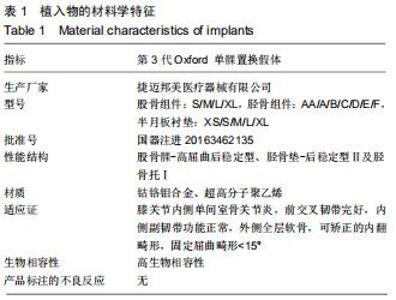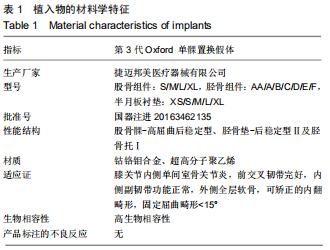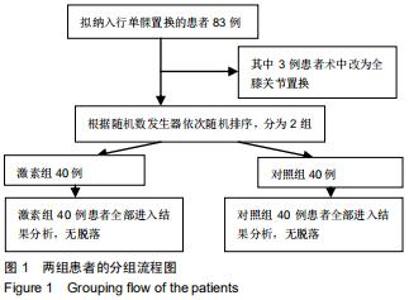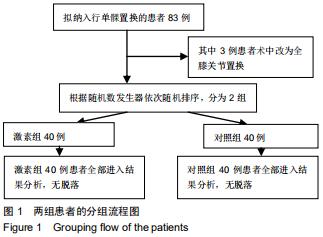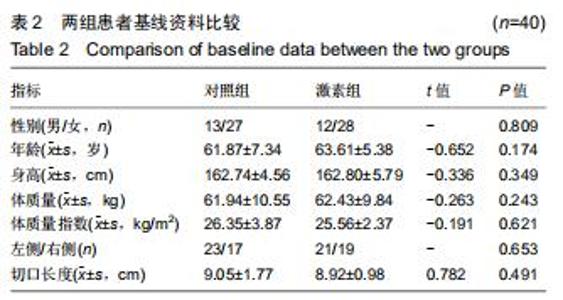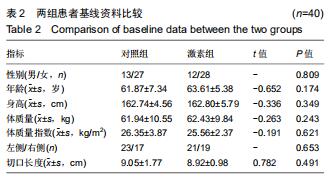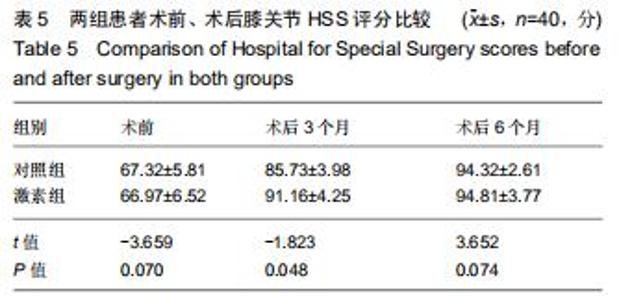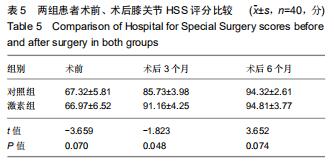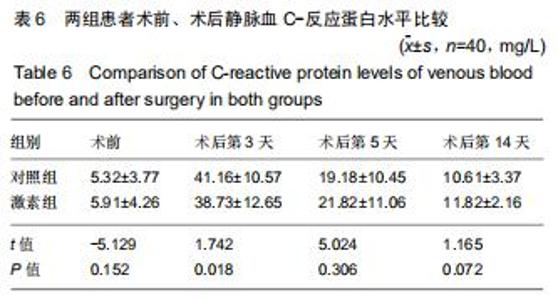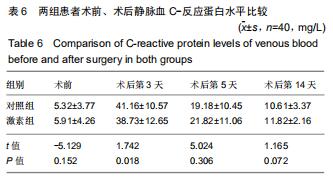Chinese Journal of Tissue Engineering Research ›› 2020, Vol. 24 ›› Issue (27): 4343-4348.doi: 10.3969/j.issn.2095-4344.2757
Previous Articles Next Articles
Adding hormone in cocktail promotes rapid recovery after unicompartmental knee arthroplasty
Yue Ju’an1, Zhang Qidong2, Huang Cheng2, Guo Wanshou2, Wang Weiguo2, Wang Randong1
- 1Department of Joint Surgery, Aviation General Hospital, Beijing 100012, China; 2Department of Joint Surgery, China-Japan Friendship Hospital, Beijing 100029, China
-
Received:2020-01-17Revised:2020-01-20Accepted:2020-02-22Online:2020-09-28Published:2020-09-09 -
Contact:Zhang Qidong, MD, Associate chief physician, Department of Joint Surgery, China-Japan Friendship Hospital, Beijing 100029, China Wang Randong, MD, Chief physician, Department of Joint Surgery, Aviation General Hospital, Beijing 100012, China -
About author:Yue Ju’an, MD, Attending physician, Department of Joint Surgery, Aviation General Hospital, Beijing 100012, China -
Supported by:the Doctor Special Fund of Aviation General Hospital, No. BS2019-005; the Capital Health Development Transfer Foundation, No. 2016-4-4062
CLC Number:
Cite this article
Yue Ju’an, Zhang Qidong, Huang Cheng, Guo Wanshou, Wang Weiguo, Wang Randong. Adding hormone in cocktail promotes rapid recovery after unicompartmental knee arthroplasty[J]. Chinese Journal of Tissue Engineering Research, 2020, 24(27): 4343-4348.
share this article
|
[1] PRICE AJ, SVARD U. A second decade lifetable survival analysis of the Oxford unicompartmental knee arthroplasty. Clin Orthop Relat Res. 2011;469(1):174-179.
[2] NOTICEWALA MS, GELLER JA, LEE JH, et al. Unicompartmental knee arthroplasty relieves pain and improves function more than total knee arthroplasty. J Arthroplasty. 2012;27(8 Suppl):99-105.
[3] PANDIT H, JENKINS C, GILL HS, et al. Minimally invasive Oxford phase 3 unicompartmental knee replacement: results of 1000 cases. J Bone Joint Surg Br. 2011;93(2):198-204.
[4] PINSORNSAK P, NANGNUAL S, BOONTANAPIBUL K. Multimodal infiltration of local anaesthetic in total knee arthroplasty; is posterior capsular infiltration worth the risk? a prospective, double-blind, randomised controlled trial. Bone Joint J. 2017;99-B(4):483-488.
[5] ANDERSEN KV, NIKOLAJSEN L, HARALDSTED V, et al. Local infiltration analgesia for total knee arthroplasty: should ketorolac be added?. Br J Anaesth. 2013;111(2):242-248.
[6] 赵学千,贾育松,孙旗,等.关节镜清理联合术后针刺与鸡尾酒疗法治疗膝骨关节炎[J].中华关节外科杂志(电子版),2018,12(5):681-686.
[7] 李国庆,王添兴,莫和塔尔·莫敏,等.全膝关节置换多模式镇痛:吗啡与鸡尾酒镇痛的疗效对比[J].中国组织工程研究,2018,22(27):4265-4270.
[8] 白斌.经皮穴位电刺激联合“鸡尾酒”疗法对全膝关节置换术后疼痛控制的临床研究[D]. 济南:山东中医药大学,2018.
[9] 余振阳.“鸡尾酒”配方药物与氨甲环酸联合应用于单侧膝关节置换术[D]. 北京:中国人民解放军总医院,解放军医学院,解放军总医院,军医进修学院, 2017.
[10] 何智超.氨甲环酸与镇痛鸡尾酒在全膝关节置换术中局部联合应用的研究[D]. 重庆:第三军医大学,中国人民解放军陆军军医大学, 2017.
[11] LIU P, GUO WS, ZHANG QD, et al. Efficacy and safety of compound betamethasone cocktail therapy in primary unilateral unicompartmental knee arthroplasty. Zhonghua Yi Xue Za Zhi. 2019;99(39):3100-3104.
[12] FAN Z, MA J, KUANG M, et al. The efficacy of dexamethasone reducing postoperative pain and emesis after total knee arthroplasty: A systematic review and meta-analysis. Int J Surg. 2018;52:149-155.
[13] KIM JI, KIM YT, JUNG HJ, et al. Does adding corticosteroids to periarticular injection affect the postoperative acute phase response after total knee arthroplasty? Knee. 2019. pii: S0968-0160(19)30255-8.
[14] 郭万首.单髁关节置换的病例选择[J].中华关节外科杂志(电子版), 2015, 9(3):377-379.
[15] SHI ZB, DANG XQ. Efficacy of multimodal perioperative analgesia protocol with periarticular medication injection and nonsteroidal anti-inflammatory drug use in total knee arthroplasty. Niger J Clin Pract. 2018;21(9): 1221-1227.
[16] PANG HN, LO NN, YANG KY, et al. Peri-articular steroid injection improves the outcome after unicondylar knee replacement: a prospective, randomised controlled trial with a two-year follow-up. J Bone Joint Surg Br. 2008;90(6):738-744.
[17] BRAVIN LN, ERNEST EP, DIETZ MJ, et al. Liposomal bupivacaine offers no benefit over ropivacaine for multimodal periarticular injection in total knee arthroplasty. Orthopedics. 2019:1-6.
[18] FISCHER HB, SIMANSKI CJ. A procedure-specific systematic review and consensus recommendations for analgesia after total hip replacement. Anaesthesia. 2005;60(12):1189-1202.
[19] TRUONG A, MUJUKIAN A, FLESHNER P, et al. No pain, more gain: reduced postoperative opioid consumption with a standardized opioid-sparing multimodal analgesia protocol in opioid-tolerant patients undergoing colorectal surgery. Am Surg. 2019;85(10):1155-1158.
[20] SCHNEIDER J, BROOME B, KEELEY D. Narcotic-free perioperative total knee arthroplasty: does the periarticular injection medication make a difference? J Knee Surg. 2019. doi: 10.1055/s-0039-1696975.
[21] LAKRA A, GROSSO M, JENNINGS EL, et al. Improved pain control with adductor canal block using liposomal bupivacaine after total knee replacement: a retrospective cohort study. Arthroplast Today. 2019; 5(3):325-328.
[22] TOFTDAHL K, NIKOLAJSEN L, HARALDSTED V, et al. Comparison of peri- and intraarticular analgesia with femoral nerve block after total knee arthroplasty: a randomized clinical trial. Acta Orthop. 2007;78(2):172-179.
[23] FAN JC. Intra-operative periarticular multimodal injection in total knee arthroplasty: a local hospital experience in Hong Kong. Hong Kong Med J. 2018;24(2):145-151.
[24] MULLAJI A, KANNA R, SHETTY GM, et al. Efficacy of periarticular injection of bupivacaine, fentanyl, and methylprednisolone in total knee arthroplasty:a prospective, randomized trial. J Arthroplasty. 2010; 25(6):851-857.
[25] MAHESHWARI AV, BLUM YC, SHEKHAR L, et al. Multimodal pain management after total hip and knee arthroplasty at the Ranawat Orthopaedic Center. Clin Orthop Relat Res. 2009;467(6):1418-1423.
[26] LAMPLOT JD, WAGNER ER, MANNING DW. Multimodal pain management in total knee arthroplasty: a prospective randomized controlled trial. J Arthroplasty. 2014;29(2):329-334.
[27] WU JW, WONG YC. Elective unilateral total knee replacement using continuous femoral nerve blockade versus conventional patient-controlled analgesia: perioperative patient management based on a multidisciplinary pathway. Hong Kong Med J. 2014;20(1):45-51.
[28] YAYAC M, LI WT, ONG AC, et al. The Efficacy of Liposomal Bupivacaine Over Traditional Local Anesthetics in Periarticular Infiltration and Regional Anesthesia During Total Knee Arthroplasty: A Systematic Review and Meta-Analysis. J Arthroplasty. 2019;34(9):2166-2183.
[29] AFFAS F, NYGÅRDS EB, STILLER CO, et al. Pain control after total knee arthroplasty: a randomized trial comparing local infiltration anesthesia and continuous femoral block. Acta Orthop. 2011;82(4):441-447.
[30] SPANGEHL MJ, CLARKE HD, HENTZ JG, et al. The Chitranjan Ranawat Award: Periarticular injections and femoral & sciatic blocks provide similar pain relief after TKA: a randomized clinical trial. Clin Orthop Relat Res. 2015;473(1):45-53.
[31] HYLAND SJ, DELIBERATO DG, FADA RA, et al. Liposomal bupivacaine versus standard periarticular injection in total knee arthroplasty with regional anesthesia: a prospective randomized controlled trial. J Arthroplasty. 2019;34(3):488-494.
[32] VENDITTOLI PA, MAKINEN P, DROLET P, et al. A multimodal analgesia protocol for total knee arthroplasty. A randomized, controlled study. J Bone Joint Surg Am. 2006;88(2):282-289.
[33] LAORUENGTHANA A, JARUSRIWANNA A, RATTANAPRICHAVEJ P, et al. Timing of periarticular injection has no effect on postoperative pain and functional recovery in simultaneous bilateral total knee arthroplasty: a prospective randomized, double-blinded trial. BMC Musculoskelet Disord. 2019;20(1):162.
[34] RASMUSSEN S, KRAMHØFT MU, SPERLING KP, et al. Increased flexion and reduced hospital stay with continuous intraarticular morphine and ropivacaine after primary total knee replacement: open intervention study of efficacy and safety in 154 patients. Acta Orthop Scand. 2004;75(5):606-609.
[35] HOSHIKAWA N, SAKAI A, TAKAI S, et al. Targeting Extracellular miR-21-TLR7 Signaling Provides Long-Lasting Analgesia in Osteoarthritis. Mol Ther Nucleic Acids. 2019;19:199-207.
[36] MEHTA S, AKHTAR S, PORTER RM, et al. Interleukin-1 receptor antagonist (IL-1Ra) is more effective in suppressing cytokine-induced catabolism in cartilage-synovium co-culture than in cartilage monoculture. Arthritis Res Ther. 2019;21(1):238.
[37] LEE JH, WANG SI, NOH SJ, et al. Osteonecrosis of the medial tibial plateau after intra-articular corticosteroid injection: A case report. Medicine (Baltimore). 2019;98(44):e17248.
[38] CHRISTENSEN CP, JACOBS CA, JENNINGS HR. Effect of periarticular corticosteroid injections during total knee arthroplasty. A double-blind randomized trial. J Bone Joint Surg Am. 2009;91(11): 2550-2555.
[39] ARMSTRONG RW, BOLDING F, JOSEPH R. Septic arthritis following arthroscopy: clinical syndromes and analysis of risk factors. Arthroscopy. 1992;8(2):213-223.
[40] GRAY RG, GOTTLIEB NL. Intra-articular corticosteroids. An updated assessment. Clin Orthop Relat Res. 1983;(177):235-263.
[41] FITZGERALD RH. Intrasynovial injection of steroids uses and abuses. Mayo Clin Proc. 1976;51(10):655-659.
[42] LAZAREVIC MB, SKOSEY JL, DJORDJEVIC-DENIC G, et al. Reduction of cortisol levels after single intra-articular and intramuscular steroid injection. Am J Med. 1995;99(4):370-373.
[43] ANKAY YA, AKCA B, BUYUKAKKUS B, et al. Procaine and saline have similar effects on articular cartilage and synovium in rat knee. BMC Anesthesiol. 2018;18(1):51.
[44] ZLOTNICKI JP, HAMLIN BR, PLAKSEYCHUK AY, et al. Liposomal Bupivacaine vs Plain Bupivacaine in Periarticular Injection for Control of Pain and Early Motion in Total Knee Arthroplasty: A Randomized, Prospective Study. J Arthroplasty. 2018;33(8):2460-2464.
[45] 彭慧明,唐杞衡,钱文伟,等.膝关节周围注射镇痛在全膝关节置换术后多模式镇痛方案中的作用[J].中华骨科杂志,2016,36(7):406-412.
[46] HUIMING P, QIHENG T, WENWEI Q, et al.A randomized controlled trial on additional efficacy of local anesthetic injection on multimodal analgesia in total knee arthroplasty. Chin J Orthop. 2016;(7):406-412.
[47] ALLEN GC, ST AMA, LUI AC, et al. Postarthroscopy analgesia with intraarticular bupivacaine/morphine. A randomized clinical trial. Anesthesiology. 1993;79(3):475-480.
[48] TANAKA N, SAKAHASHI H, SATO E, et al. The efficacy of intra-articular analgesia after total knee arthroplasty in patients with rheumatoid arthritis and in patients with osteoarthritis. J Arthroplasty. 2001;16(3):306-311.
[49] HIRASAWA N, KUROSAKA K, NISHINO M, et al. No clinically important difference in pain scores after tha between periarticular analgesic injection and placebo: a randomized trial. Clin Orthop Relat Res. 2018;476(9):1837-1845.
[50] SVIRSKIS D, MARTIS W, BHUSAL P, et al. Analysis of the postoperative periarticular environment and influence on sustained drug delivery from a gel formulation. J Pharm Sci. 2018;107(9): 2399-2403. |
| [1] | Huang Dengcheng, Wang Zhike, Cao Xuewei. Comparison of the short-term efficacy of extracorporeal shock wave therapy for middle-aged and elderly knee osteoarthritis: a meta-analysis [J]. Chinese Journal of Tissue Engineering Research, 2021, 25(9): 1471-1476. |
| [2] | Peng Zhihao, Feng Zongquan, Zou Yonggen, Niu Guoqing, Wu Feng. Relationship of lower limb force line and the progression of lateral compartment arthritis after unicompartmental knee arthroplasty with mobile bearing [J]. Chinese Journal of Tissue Engineering Research, 2021, 25(9): 1368-1374. |
| [3] | Liu Xiangxiang, Huang Yunmei, Chen Wenlie, Lin Ruhui, Lu Xiaodong, Li Zuanfang, Xu Yaye, Huang Meiya, Li Xihai. Ultrastructural changes of the white zone cells of the meniscus in a rat model of early osteoarthritis [J]. Chinese Journal of Tissue Engineering Research, 2021, 25(8): 1237-1242. |
| [4] | Zhao Zhongyi, Li Yongzhen, Chen Feng, Ji Aiyu. Comparison of total knee arthroplasty and unicompartmental knee arthroplasty in treatment of traumatic osteoarthritis [J]. Chinese Journal of Tissue Engineering Research, 2021, 25(6): 854-859. |
| [5] | Liu Shaohua, Zhou Guanming, Chen Xicong, Xiao Keming, Cai Jian, Liu Xiaofang. Influence of anterior cruciate ligament defect on the mid-term outcome of fixed-bearing unicompartmental knee arthroplasty [J]. Chinese Journal of Tissue Engineering Research, 2021, 25(6): 860-865. |
| [6] | Zhang Nianjun, Chen Ru. Analgesic effect of cocktail therapy combined with femoral nerve block on total knee arthroplasty [J]. Chinese Journal of Tissue Engineering Research, 2021, 25(6): 866-872. |
| [7] | Cao Xuhan, Bai Zixing, Sun Chengyi, Yang Yanjun, Sun Weidong. Mechanism of “Ruxiang-Moyao” herbal pair in the treatment of knee osteoarthritis based on network pharmacology [J]. Chinese Journal of Tissue Engineering Research, 2021, 25(5): 746-753. |
| [8] | Li Yonghua, Feng Qiang, Tan Renting, Huang Shifu, Qiu Jinlong, Yin Heng. Molecular mechanism of Eucommia ulmoides active ingredients treating synovitis of knee osteoarthritis: an analysis based on network pharmacology [J]. Chinese Journal of Tissue Engineering Research, 2021, 25(5): 765-771. |
| [9] | Song Shan, Hu Fangyuan, Qiao Jun, Wang Jia, Zhang Shengxiao, Li Xiaofeng. An insight into biomarkers of osteoarthritis synovium based on bioinformatics [J]. Chinese Journal of Tissue Engineering Research, 2021, 25(5): 785-790. |
| [10] | Deng Zhenhan, Huang Yong, Xiao Lulu, Chen Yulin, Zhu Weimin, Lu Wei, Wang Daping. Role and application of bone morphogenetic proteins in articular cartilage regeneration [J]. Chinese Journal of Tissue Engineering Research, 2021, 25(5): 798-806. |
| [11] | Liu Xin, Yan Feihua, Hong Kunhao. Delaying cartilage degeneration by regulating the expression of aquaporins in rats with knee osteoarthritis [J]. Chinese Journal of Tissue Engineering Research, 2021, 25(5): 668-673. |
| [12] | Ma Zetao, Zeng Hui, Wang Deli, Weng Jian, Feng Song. MicroRNA-138-5p regulates chondrocyte proliferation and autophagy [J]. Chinese Journal of Tissue Engineering Research, 2021, 25(5): 674-678. |
| [13] | Zheng Li, Li Dadi, Hu Weifan, Tang Jinlong, Zhao Fengchao. Risk assessment of contralateral knee arthroplasty after unilateral total knee arthroplasty [J]. Chinese Journal of Tissue Engineering Research, 2021, 25(3): 374-379. |
| [14] | Lü Jiaxing, Bai Leipeng, Yang Zhaoxin, Miao Yuesong, Jin Yu, Li Zhehong, Sun Guangpu, Xu Ying, Zhang Qingzhu. Evaluation of internal fixation with proximal femoral nail antirotation in elderly knee osteoarthritis patients with femoral intertrochanteric fractures [J]. Chinese Journal of Tissue Engineering Research, 2021, 25(3): 391-396. |
| [15] | Li Kun, Li Zhijun, Zhang Shaojie, Gao Shang, Sun Hao, Yang Xi, Wang Xing, Dai Lina . A 4-year-old child model of occipito-atlanto-axial joints established by finite element dynamic simulation [J]. Chinese Journal of Tissue Engineering Research, 2021, 25(24): 3773-3778. |
| Viewed | ||||||
|
Full text |
|
|||||
|
Abstract |
|
|||||
